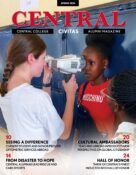In Walt Whitman’s classic poem A Noiseless, Patient Spider, the poet describes a quiet arachnid that “launch’d forth filament, filament, filament, out of itself.” These are words that nearly every Central freshman will become terribly familiar with this fall. During a required first-semester course, freshmen will be asked to consider what the poet meant when he penned those lines. Most frustratingly, they will undoubtedly be asked what that spider’s web-making habits have to do with them.
Since 2002, every freshman entering their fall semester at Central College has been given the same initiation into the Central experience: the Intersections course. Taught by faculty from all academic departments, Intersections is designed to introduce new students to their liberal arts education, give them the skills to succeed and help them take full advantage of their time at Central. Whitman’s poem has become a staple in the Intersections anthology.
In addition to honing students’ academic skills—research, writing, discussion—faculty have designed the course for students to interact with the liberal arts approach. Intersections asks students to study perspectives on human nature. More exactly, it helps students to understand interdisciplinary study.
“We’re trying to get them to understand that the liberal arts is really about learning from a lot of different perspectives,” explains Peggy Fitch, Intersections program director and professor of psychology, “and also get them to appreciate what these different perspectives have to offer.”

When selecting their Intersections course, students choose between sections with different subthemes, such as conflict and human nature, global perspectives and human nature and scientific approaches to human nature, among others.
By integrating common readings and convocations with more individualized study, students are shown how one discipline can lend itself to another—that the study of music can mesh with biology or psychology, for example. “To me it’s like concentric circles,” says Alida Droppert, assistant professor of education, currently teaching a section on global perspectives. “They’ve already moved beyond their high schools into a larger environment. I want them now to see that they can make connections with the community at Central College and also develop a broader global perspective.”
Since it’s designed to encourage students to engage with new ideas, the course may be completely foreign to the classroom experience students know from high school. “It focuses a
lot on ambiguity,” explains Mary Stark, professor of English, who is teaching Intersections from a scientific approach. “It’s not always comfortable, either,” she says. This is an intentional choice by the faculty; they hope to take students out of their comfort zones and get them to consider new perspectives.
One of the biggest challenges of teaching the course is getting 18- and 19-year-old students to engage in the material. Professors acknowledge that it can be difficult for a freshman to comprehend the purpose and benefits of the class. “I don’t like it,” freshman Sam Burgin bashfully confirms. “It makes you read a lot.”
Many students just out of high school are most concerned about work load. “It’s an academically challenging course,” Fitch verifies. In addition to reading, writing informally, participating in discussions and sometimes giving presentations, students complete 15-20 pages of formal writing throughout the semester, more than most students have done before. “Most of the complaints are about the writing we have to do,” explains freshman Alli Zuel.
The concern could be that the students are so put off by the workload that they don’t appreciate the lessons the class teaches. Despite the program’s commendable goals, can the Intersections council be certain the lessons are not falling on deaf ears?

“We wrote a lot of papers,” acknowledges junior biology major Emery Davis with a laugh, as he recalls his own Intersections experience. Like some others, Davis didn’t care for the course when he took it. But that did not prevent him from gaining a liberal arts perspective. Davis found his Intersections professor so interesting that he took an anthropology class from him sophomore year, and he hopes to take even more. Intersections provided the space for him to develop a passion for a new discipline.
This is where the Intersections program excels: fostering a liberal arts attitude. Despite being a first-semester annoyance to some students, freshmen come away with an appreciation for ways of thinking they may not confront in their major studies.
“The thing I liked the best was that we controlled the class,” says sophomore political science major Miranda Wehde. “We’re sitting there contemplating our ideas.” She has found that this skill of confronting new perspectives has served her well academically.
“I try to expand their horizons,” Droppert says of her Intersections students. “So they can look beyond Central, to the greater community. To the world.”













To encourage serious, intellectual discourse on Civitas, please include your first and last name when commenting. Anonymous comments will be removed.
Comments are closed.